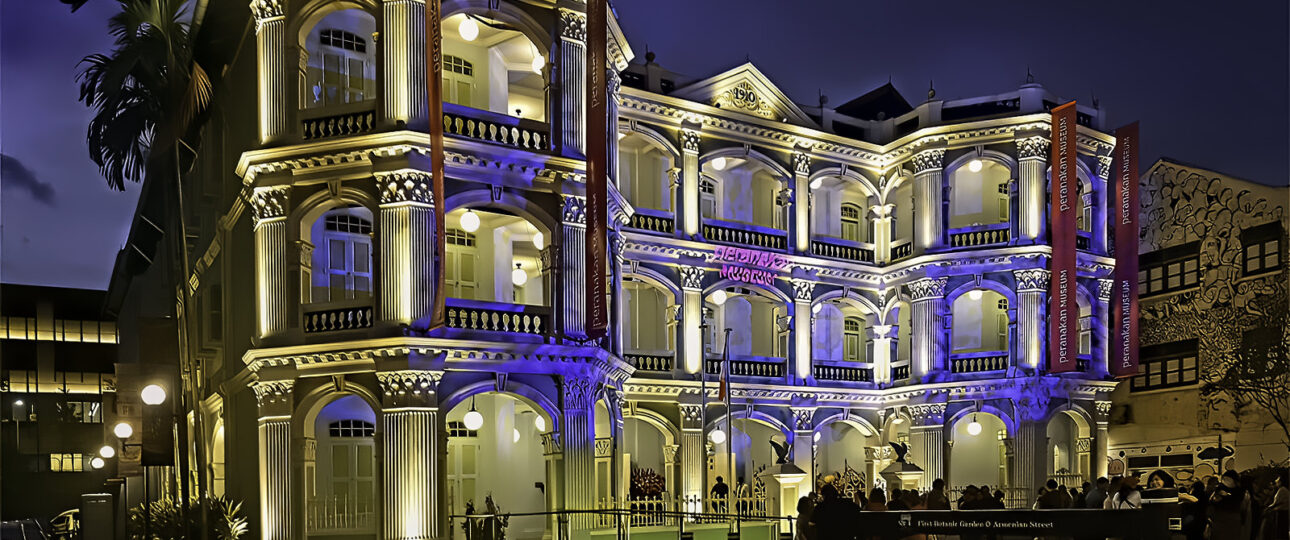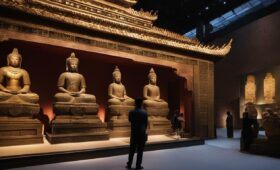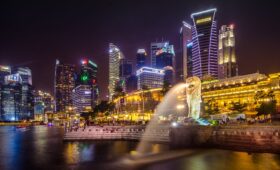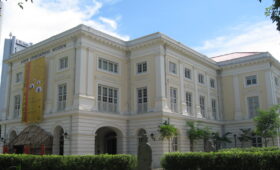Discover the vibrant cultural tapestry of the Peranakan communities at the Peranakan Museum Singapore. Immerse yourself in the rich heritage and traditions that have shaped the multiethnic fabric of Southeast Asia.
After extensive renovations, the museum has reopened its doors, unveiling brand-new permanent galleries that showcase the exceptional objects and artifacts of Peranakan material culture. From intricately crafted textiles and heirloom jewelry to beautifully decorated Peranakan homes, the museum offers a comprehensive exploration of Peranakan identity.
Key Takeaways:
- Peranakan Museum Singapore celebrates the rich heritage and culture of the Peranakan communities.
- Renovated galleries provide a multi-faceted experience, featuring Peranakan objects, artifacts, and contemporary expressions of Peranakan culture.
- Explore the origins, home, style, and contemporary art installations that reflect the Peranakan culture’s evolution.
- Peranakan Museum Singapore highlights the cultural diversity and contributions of the Peranakan communities to Singapore’s identity.
- Immerse yourself in the charm and authenticity of Peranakan heritage at the museum.
Peranakan Museum: A Journey through Origins
The first floor of the Peranakan Museum is dedicated to exploring the origins of the Peranakan culture. This immersive gallery takes visitors on a journey through the diverse communities that make up the Peranakan heritage, including Arab Peranakans, Chinese Peranakans, Chitty Melakans, Eurasian Peranakans, and Jawi Peranakans. By showcasing interactive exhibits and video interviews, visitors gain a deeper understanding of the multicultural and inclusive nature of Peranakan communities.
The gallery provides a comprehensive insight into the personal experiences and perspectives of individuals from different Peranakan backgrounds, highlighting the significance of their heritage and what it means to be Peranakan. Through storytelling and interactive displays, visitors can immerse themselves in the rich tapestry of Peranakan culture and appreciate the diversity that has shaped this unique community.
The Origins of Peranakan Culture
In the gallery, visitors can explore artifacts and objects that exemplify the cultural exchange and fusion that defines Peranakan culture. From traditional costumes and jewelry to religious items and everyday utensils, each piece tells a story of the intermingling of traditions and customs. This floor of the museum allows visitors to delve into the origins of Peranakan communities and appreciate the complex network of influences that have shaped their identity.
| Peranakan Communities | Origins |
|---|---|
| Arab Peranakans | Arab and Malay heritage |
| Chinese Peranakans | Chinese and Malay heritage |
| Chitty Melakans | Indian Hindu and Malay heritage |
| Eurasian Peranakans | European and Malay heritage |
| Jawi Peranakans | Arab and Malay heritage |
This floor of the Peranakan Museum Singapore offers a captivating exploration of the origins of Peranakan culture, inviting visitors to appreciate the diverse heritage and rich tapestry of influences that have shaped this unique community.
The Origins of Peranakan Culture
- Explore the diverse origins of Peranakan communities
- Gain insights into the multicultural and inclusive nature of Peranakan culture
- Discover personal stories and perspectives of individuals from different Peranakan backgrounds
- Appreciate the intermingling of traditions and customs in Peranakan artifacts and objects
Unveiling Peranakan Home and Family Life
The second floor of the Peranakan Museum focuses on the theme of home and family life. Visitors can explore different Peranakan homes in Singapore, with furniture, portraits, and furnishings grouped according to their shared homes. The gallery provides insights into the social life, pastimes, entertainments, and the renowned Peranakan culinary culture. The display includes nyonyaware, traditional dining ware, and a traditional long dining table called tok panjang. It offers visitors a glimpse into the intimate aspects of Peranakan family and community life.
Peranakan Homes: A Window into Tradition
Peranakan homes are known for their vibrant colors, ornate decor, and intricate designs. The second floor of the museum showcases the distinctive architectural features and interior design elements that define these homes. From elaborately carved wooden furniture to intricately embroidered curtains, visitors can immerse themselves in the unique aesthetics of Peranakan homes. The museum’s collection also includes portraits that capture the essence of Peranakan family life, showcasing the importance of tradition and heritage in their households.
A Culinary Journey into Peranakan Culture
One of the highlights of the second floor is the exploration of Peranakan culinary culture. Visitors can learn about the traditional recipes, cooking techniques, and dining customs that have been passed down through generations. The exhibition features displays of Nyonyaware, which includes intricately decorated porcelain and ceramic ware used in Peranakan households. The traditional long dining table, tok panjang, is also on display, showcasing the elaborate feasts and communal dining experiences that are integral to Peranakan family gatherings.
| Key Features of Peranakan Home and Family Life | |
|---|---|
| Vibrant Colors and Ornate Decor | The interiors of Peranakan homes are known for their vibrant colors and intricate decor, reflecting the rich cultural heritage of the community. |
| Traditional Dining Ware | Visitors can admire the beautifully crafted nyonyaware and learn about the significance of the dining culture in Peranakan households. |
| Community and Family Bonds | The exhibition offers a deeper understanding of the strong family ties and communal traditions that are central to Peranakan identity. |
Exploring the second floor of the Peranakan Museum provides visitors with a fascinating insight into the daily lives, customs, and traditions of Peranakan families. From the vibrant colors and intricate designs of their homes to the mouth-watering culinary traditions, this section of the museum offers a comprehensive and immersive experience of Peranakan home and family life.
Peranakan Style and Decorative Arts
The third floor of the Peranakan Museum is a treasure trove for enthusiasts of Peranakan style and decorative arts. This floor showcases the intricate Peranakan textiles, including batik, and various decorative arts that adorn the Peranakan household. Visitors can immerse themselves in the rich tapestry of Peranakan culture through the vibrant displays of Peranakan needlework, which highlight the meticulous beadwork that goes into traditional clothing. The jewelry gallery is a sight to behold, boasting over 180 heirloom pieces, including necklaces, hairpins, and other adornments from different Peranakan communities. These exquisite pieces are a testament to the Peranakan community’s appreciation for beauty and craftsmanship.
In addition to textiles and jewelry, the gallery also features a wide range of other decorative arts. Intricately carved furniture, delicate porcelain, and ornate ceramics offer a glimpse into the opulent lifestyle of the Peranakans. Each piece tells a story, blending Chinese, Malay, and Indonesian influences into a unique fusion of styles. The mastery of craftsmanship is evident in every detail, showcasing the Peranakan people’s dedication to preserving their cultural heritage through art and design.
As you explore the third floor, you will also encounter the iconic sarong kebaya, a traditional Peranakan outfit that has become synonymous with Peranakan fashion. The sarong kebaya exemplifies the elegance and grace of Peranakan style, with its intricate embroidery and vibrant colors. It is a symbol of Peranakan identity that has withstood the test of time.
Peranakan Textiles: A Feast for the Senses
One of the highlights of the third floor is the extensive collection of Peranakan textiles. These textiles are not only visually stunning but also tell stories of tradition, culture, and personal expression. From intricate batik patterns to delicate embroidery, Peranakan textiles are a feast for the senses. The gallery offers a fascinating exploration of the techniques, motifs, and symbolism behind these intricate creations, showcasing the unique blend of influences that make Peranakan textiles truly distinctive.
Contemporary Art Installations at Peranakan Museum
The Peranakan Museum incorporates contemporary art installations that reflect the tension between tradition and modernity in Peranakan culture. One of the central installations is “Coming Home” by artist Sam Lo, which celebrates the cultural identity of Peranakan communities. In this thought-provoking piece, Lo explores the themes of heritage, belonging, and the journey of self-discovery. The installation combines vibrant colors, traditional motifs, and modern mediums to create a visually striking and emotionally resonant experience. Through “Coming Home,” visitors are invited to reflect on their own cultural heritage and the importance of embracing and preserving the traditions that shape their identities.
Another captivating artwork at the Peranakan Museum is “Sheltered Dreams” by Lavender Chang. This installation transports viewers into the heart of Peranakan homes, capturing the essence of everyday life. Chang’s meticulous attention to detail and use of mixed media create a realistic and immersive representation of living rooms in HDB homes. Visitors can admire the intricacies of Peranakan interior design, from the ornate furniture to the vibrant wallpaper patterns. “Sheltered Dreams” offers a glimpse into the past and invites viewers to appreciate the beauty and authenticity of Peranakan home life.
Contemporary Art Installations at Peranakan Museum
| Artwork | Artist | Description |
|---|---|---|
| “Coming Home” | Sam Lo | Celebrates the cultural identity of Peranakan communities through vibrant colors and traditional motifs. |
| “Sheltered Dreams” | Lavender Chang | Offers a realistic and immersive representation of Peranakan home life in HDB living rooms. |
These contemporary art installations at the Peranakan Museum encapsulate the dynamic nature of Peranakan culture and its ability to evolve while staying rooted in tradition. By integrating modern artistic expressions with traditional themes and motifs, the museum fosters a deeper understanding of the ongoing cultural dialogue within the Peranakan community. Visitors can engage with these thought-provoking installations and gain a renewed appreciation for the rich and diverse heritage of Peranakan culture.
Family-friendly Experience: Peranakan Museum for Kids
Families visiting the Peranakan Museum can enjoy a fun and educational experience together with their children. The museum has taken special care to cater to younger audiences, ensuring that kids are engaged and can easily understand and appreciate the exhibits.
One of the features that make the museum family-friendly is the use of special labels. Pink labels labeled “Anak Anak” are strategically placed throughout the museum to provide child-friendly information about the exhibits. These labels help children connect with the displays and learn about the Peranakan culture in a way that is accessible and engaging for their age group.
In addition to the labels, the Peranakan Museum also provides an activity area dedicated to children on the third floor. Here, kids can participate in hands-on activities that allow them to interact with Peranakan culture in a fun and interactive way. From arts and crafts to interactive games, this activity area is designed to spark children’s curiosity and enable them to have a hands-on experience with Peranakan traditions and customs.
| Family-Friendly Features at the Peranakan Museum |
|---|
| Pink labels labeled “Anak Anak” to engage children and make exhibits accessible |
| Activity area on the third floor for children to learn and interact with Peranakan culture |
Visiting the Peranakan Museum with your kids is not only a chance to explore the rich heritage of Peranakan culture but also an opportunity for them to learn and have fun in a family-friendly environment. The museum’s efforts to create a kid-friendly experience ensure that children can actively participate and develop an appreciation for the Peranakan traditions and customs.
Plan Your Visit to the Peranakan Museum Singapore
If you’re planning a visit to Singapore, don’t miss the opportunity to explore the Peranakan Museum. Located at 39 Armenian Street, Singapore 179941, the museum offers a fascinating glimpse into the rich heritage and culture of the Peranakan communities in Southeast Asia.
The museum is open daily from 10 am to 7 pm, with extended hours until 9 pm on Fridays. Whether you’re a Singaporean or a Permanent Resident, you can enjoy free admission to the museum, making it an accessible destination for everyone.
During your visit, you can explore the museum’s three floors, each dedicated to a different theme. From the origins of the Peranakan culture on the first floor, to the exploration of home and family life on the second floor, and the showcase of Peranakan style and decorative arts on the third floor, there is something for everyone to discover and learn.
| Opening Hours | Admission |
|---|---|
| Monday – Thursday: 10 am – 7 pm | Singaporeans: Free |
| Friday: 10 am – 9 pm | Permanent Residents: Free |
| Weekends and Public Holidays: 10 am – 7 pm | Adults: $10 |
| Seniors (60 years and above): $5 | |
| Students: $4 |
Whether you’re a history enthusiast, an art lover, or simply curious about the Peranakan culture, a visit to the Peranakan Museum is sure to be an enlightening and enriching experience. Plan your visit today and immerse yourself in the vibrant heritage of the Peranakan communities.
Peranakan Museum: A Fascinating Journey Through Time
The Peranakan Museum is housed in the historic Tao Nan School building, which operated from 1912 to 1982. This architectural gem has undergone extensive renovations and now stands as a testament to the rich history and cultural heritage of the Peranakan communities. The museum takes visitors on a fascinating journey through time, showcasing the unique blend of Chinese, Malay, and Indonesian influences that have shaped the Peranakan identity.
With its refreshed galleries and enhanced visitor experiences, the Peranakan Museum reopened its doors in February 2023. The renovations have breathed new life into the museum, allowing visitors to delve deeper into the captivating history of the Peranakans. The museum’s three floors provide a comprehensive exploration of Peranakan culture, from the origins and home life to the distinctive style and decorative arts that define the Peranakan heritage.
Through interactive exhibits, curated displays, and contemporary installations, the Peranakan Museum offers an immersive and authentic experience. Visitors can witness the evolution of Peranakan culture over time and gain a deeper appreciation for the contributions of Peranakan communities to Singapore’s cultural tapestry. This journey through time at the Peranakan Museum is both educational and visually captivating, allowing visitors to connect with the past and discover the enduring legacy of the Peranakan heritage.
The Significance of Peranakan Culture in Singapore
The Peranakan culture holds significant importance in Singapore’s cultural heritage. As a vibrant multicultural city-state, Singapore celebrates its rich diversity, and the Peranakan Museum plays a crucial role in showcasing the unique fusion of Chinese, Malay, and Indonesian influences that have shaped the Peranakan identity.
The Peranakan Museum Singapore provides a comprehensive exploration of Peranakan culture, highlighting its origins, home and family life, style, and contemporary expressions. Through its galleries, exhibitions, and collections, visitors gain a deeper understanding of Singapore’s history and the contributions made by different communities to its development.
Peranakan culture represents the harmonious coexistence of diverse traditions, customs, and languages. It is a testament to the cultural melting pot that is Singapore, showcasing the country’s commitment to preserving and promoting cultural heritage.
Table: Peranakan Cultural Diversity
| Peranakan Communities | Origins | Influences |
|---|---|---|
| Chinese Peranakans | Chinese immigrants who married local Malay women | Chinese and Malay cultures |
| Arab Peranakans | Arab traders who settled in Southeast Asia | Arab, Malay, and Indonesian cultures |
| Chitty Melakans | Indian traders who settled in Melaka | Indian, Malay, and Chinese cultures |
| Eurasian Peranakans | European men who married local Malay women | European, Malay, and Chinese cultures |
| Jawi Peranakans | Indian Muslim traders who settled in Java | Indian, Malay, and Javanese cultures |
The Peranakan Museum Singapore invites visitors to explore and appreciate the rich cultural heritage, traditions, and contributions of the Peranakan communities. It serves as a window into the past, present, and future of Singapore’s multicultural society, emphasizing the importance of cultural diversity and the preservation of unique cultural identities.
Rediscover Peranakan Heritage at the Peranakan Museum
The Peranakan Museum offers visitors the opportunity to explore and rediscover the rich heritage of the Peranakan communities. As one of Singapore’s premier cultural institutions, the museum is dedicated to showcasing the unique and vibrant Peranakan culture that has shaped the country’s identity. Through its extensive collection of artifacts, immersive exhibitions, and contemporary art installations, the museum provides a dynamic and engaging platform for cultural exploration.
Visitors can delve into the origins of the Peranakan culture on the first floor, which highlights the diverse communities that make up the Peranakan heritage, including Arab Peranakans, Chinese Peranakans, Chitty Melakans, Eurasian Peranakans, and Jawi Peranakans. The second floor invites visitors to explore Peranakan home and family life, offering insights into social customs, pastimes, and the renowned Peranakan culinary culture. On the third floor, visitors can marvel at the intricate Peranakan textiles, delicate beadwork, and heirloom jewelry that showcase the unique style of the Peranakans.
For a more contemporary perspective, the museum also incorporates art installations that reflect the tension between tradition and modernity in Peranakan culture. These installations provide a fresh and immersive experience, encouraging visitors to see the ongoing evolution of Peranakan identity. Whether you are a history enthusiast, an art lover, or simply curious about the Peranakan culture, the Peranakan Museum offers a captivating journey through time and a deeper understanding of Singaporean heritage.
Table: Explore the Peranakan Museum
| Floor | Theme |
|---|---|
| First Floor | Origins of the Peranakan Culture |
| Second Floor | Peranakan Home and Family Life |
| Third Floor | Peranakan Style and Decorative Arts |
| All Floors | Contemporary Art Installations |
Experience the Peranakan Museum’s Charm and Authenticity
The Peranakan Museum offers visitors an immersive experience that captures the charm and authenticity of Peranakan culture. From the moment you step inside, you are transported into a world of vibrant colors, intricate designs, and rich traditions. The museum’s extensive collection of cultural artifacts showcases the unique fusion of Chinese, Malay, and Indonesian influences that define the Peranakan identity.
As you explore the museum, you will have the opportunity to witness the beauty and craftsmanship of Peranakan textiles, including traditional batik and intricate beadwork. The display of heirloom jewelry, with its dazzling necklaces and ornate hairpins, offers a glimpse into the Peranakan fashion and style.
One of the highlights of the museum is the authenticity of the exhibits. Each artifact tells a story, illustrating the daily life, customs, and rituals of the Peranakan communities. From the opulent Peranakan homes with their distinctive furniture and decorations to the traditional long dining table, known as tok panjang, the museum provides a window into the intimate aspects of Peranakan family and community life.
The Peranakan Museum’s Authenticity in Art and Cultural Artifacts
In addition to the historical artifacts, the Peranakan Museum incorporates contemporary art installations that reflect the ongoing evolution of Peranakan culture. These installations, such as “Coming Home” by artist Sam Lo and “Sheltered Dreams” by Lavender Chang, offer a fresh perspective on the Peranakan identity and showcase the tensions between tradition and modernity.
Whether you are a history enthusiast, an art lover, or simply curious about different cultures, a visit to the Peranakan Museum promises an enriching and enlightening experience. Immerse yourself in the charm and authenticity of Peranakan culture as you explore the museum’s galleries and uncover the fascinating stories behind each artifact.
| Table: Highlights of the Peranakan Museum |
|---|
| Extensive collection of Peranakan objects and artifacts |
| Interactive exhibits and video interviews showcasing Peranakan culture |
| Showcase of Peranakan textiles, jewelry, and fashion |
| Contemporary art installations reflecting the evolution of Peranakan culture |
| Authentic portrayal of Peranakan homes and family life |
Conclusion
The Peranakan Museum in Singapore offers a captivating journey through the rich heritage and culture of the Peranakan communities. With its extensive collection of artifacts, immersive exhibitions, and contemporary art installations, the museum provides a multi-faceted exploration of the Peranakan identity. Visitors have the opportunity to delve into the origins, discover the nuances of Peranakan home and style, and witness the ongoing evolution of Peranakan culture.
By exploring the Peranakan Museum, visitors can gain a deeper understanding of Singapore’s cultural heritage. The museum showcases the unique fusion of Chinese, Malay, and Indonesian influences that have shaped the Peranakan identity, contributing to Singapore’s vibrant multiculturalism and cultural diversity. It provides a platform for cultural exploration, allowing visitors to rediscover the rich heritage of the Peranakan communities and forge a deeper connection to Singaporean identity.
Whether you’re interested in history, art, or simply seeking to expand your knowledge of different cultures, the Peranakan Museum offers a captivating and immersive experience. Its reopening after renovations in February 2023 marks an exciting chapter in the preservation and exploration of the Peranakan heritage in Singapore. So, come and explore the Peranakan Museum, where you can immerse yourself in the fascinating heritage, vibrant culture, and rich history of the Peranakan communities.
FAQ
What is the Peranakan Museum in Singapore?
The Peranakan Museum in Singapore offers a unique exploration of the rich heritage and culture of Peranakan communities in Southeast Asia.
What can I expect to see at the Peranakan Museum?
The museum showcases a wide range of Peranakan objects and artifacts, including textiles, decorative arts, jewelry, and traditional clothing.
What are the themes explored in the museum?
The museum is divided into three floors dedicated to the themes of origins, home, and style, providing a comprehensive understanding of Peranakan identity.
Are there contemporary art installations at the Peranakan Museum?
Yes, the museum incorporates contemporary art installations that reflect the tension between tradition and modernity in Peranakan culture.
Is the Peranakan Museum family-friendly?
Yes, the museum has special labels and activities designed for younger audiences, as well as an activity area dedicated to children.
What are the opening hours of the Peranakan Museum?
The museum is open daily from 10 am to 7 pm, and on Fridays, it remains open until 9 pm.
Is there an admission fee for the museum?
Singaporeans and Permanent Residents can enjoy free admission to the museum.
Where is the Peranakan Museum located?
The museum is located at 39 Armenian Street, Singapore 179941.
What is the significance of Peranakan culture in Singapore?
Peranakan culture holds significant importance in Singapore’s cultural heritage, showcasing the country’s vibrant multiculturalism and cultural diversity.
How can I plan my visit to the Peranakan Museum?
Visitors can plan their visit by checking the museum’s opening hours, location, and admission details on the official website or contacting the museum directly.
What is the historical significance of the Peranakan Museum’s building?
The museum is housed in the Tao Nan School building, which operated from 1912 to 1982, adding to the rich historical context of the museum.
What can I expect from the Peranakan Museum experience?
Visitors can expect an immersive and engaging experience that allows them to delve into the rich heritage and culture of the Peranakan communities in Singapore.



